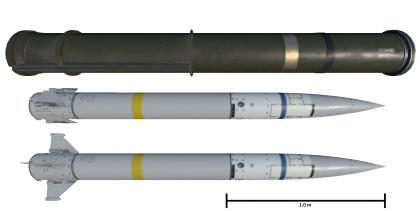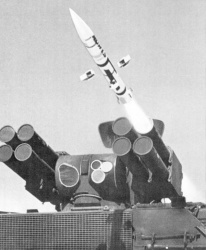MIM146
Contents
Description
The MIM146 is an American beam-riding surface-to-air missile. It was introduced in Update 1.89 "Imperial Navy".
Vehicles equipped with this weapon
General info
| Missile characteristics | |
|---|---|
| Calibre | 152 mm |
| Mass | 51 kg |
| Guidance | Beam-riding |
| Maximum speed | 1,027 m/s |
| Maximum overload | 35 G |
| Firing range | 10 km |
| Missile guidance time | 22 secs |
| Explosive mass | 7.86 kg TNTeq |
| Fuse Delay | 0.05 m |
| Fuse Sensitivity | 0.1 mm |
| Arming distance | 300 m |
| Trigger radius | 6 m |
| Penetration statistics | |||||||
|---|---|---|---|---|---|---|---|
| Ammunition | Type of warhead |
Penetration @ 0° Angle of Attack (mm) | |||||
| 10 m | 100 m | 500 m | 1,000 m | 1,500 m | 2,000 m | ||
| MIM146 | ATGM | 900 | 900 | 900 | 900 | 900 | 900 |
| Shell details | ||||||||||
|---|---|---|---|---|---|---|---|---|---|---|
| Ammunition | Type of warhead |
Velocity (m/s) |
Range (m) |
Projectile Mass (kg) |
Fuse delay (m) |
Fuse sensitivity (mm) |
Explosive Mass (TNT equivalent) (g) |
Ricochet | ||
| 0% | 50% | 100% | ||||||||
| MIM146 | ATGM | 1,027 | 10,000 | 51 | 0 | 0.1 | 7,860 | 80° | 82° | 90° |
Effective damage
Describe the type of damage produced by this type of missile (high explosive, splash damage, etc)
Comparison with analogues
Give a comparative description of missiles that have firepower equal to this weapon.
Usage in battles
Describe situations when you would utilise this missile in-game (vehicle, pillbox, base, etc)
Pros and cons
Summarise and briefly evaluate the weaponry in terms of its characteristics and combat effectiveness. Mark pros and cons as a list.
Pros:
- High speed
- Effective against both ground and air targets
- Can even destroy targets with overpressure as well as having high penetration for an ATGM
Cons:
- Can be hard to guide
- Not tandem charge; can be negated by ERA
History
In the 1970s, the Swiss company Oerlikon-Bührle company researched into the viability of a low-cost anti-aircraft missile that can also act in an anti-tank role. Designated under ADATS, Oerlikon partnered with the American company Martin Marietta in 1979 for the missile program. The first missile firing was conducted in June 1981.[1]
In 1986, the Canadian Forces accepted the missile as part of their LLAD program.[1][2] The first deliveries begun in 1988 with a total of 36 ADATS weapons procured by 1994.[1][3][4] The ADATS would serve in the Canadian military until 31 March 2011.[2]
In the United States, as the M247 DIVAD vehicle was cancelled in 1985, the search was still on for a FAAD (Forward-Area Air Defense) weapon to replace aging equipment such as the MIM-72 Chaparral. In 1989, the ADATS was evaluated as a LOS-F-H air defense system, with the missiles designated the MIM146. However, the MIM146 was found to have low reliability during testing of the equipment in combat conditions, and so the ADATS procurement was cancelled in 1992.[1] To fill in their role, the Bradley Stinger Fighting Vehicle was obtained, mounting FIM-92 Stinger missiles as their primary anti-aircraft weapon.[1][3]
Another user of the ADATS missile is the Royal Thai Air Force, who have linked them to their Skyguard fire control radar system[4]
Media
- Videos
See also
Links to the articles on the War Thunder Wiki that you think will be useful for the reader, for example:
- reference to the article about the variant of the weapon;
- references to approximate analogues by other nations and research trees.
External links
References
- Citations
- Bibliography
- Army Technology. "ADATS Short Range Air Defence System." Army Technology, Verdict Media Limited, Website. Accessed 21 Mar. 2021 (Archive).
- Parsch, Andreas. "MIM-146." Directory of U.S. Military Rockets and Missiles, Designation-Systems.Net, 05 Nov. 2002, Website. Accessed 21 Mar. 2021 (Archive).
- Pike, John; Sherman, Robert. "Air Defense Anti-Tank System [ADATS]." Federation of American Scientists - Military Analysis Network, 02 Jul. 1999, Website. Accessed 21 Mar. 2021 (Archive).
- Rheinmetall Canada Inc. "History." Rheinmetall Canada Inc., Website. Accessed 21 Mar. 2021 (Archive).





